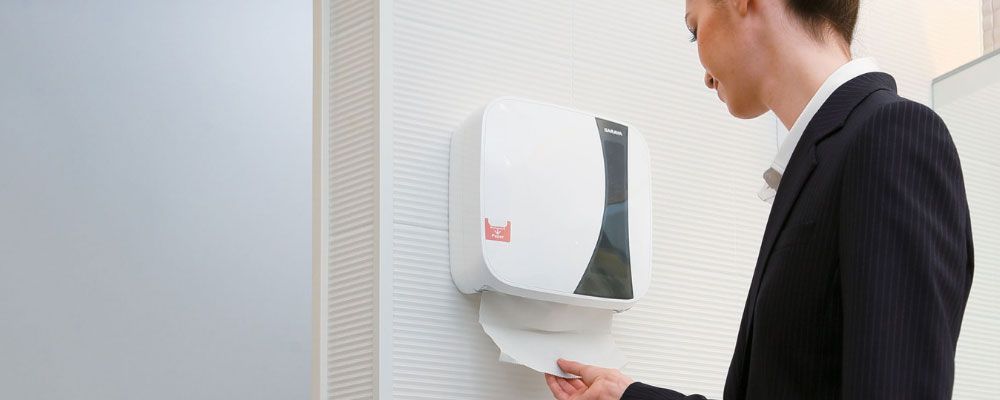
Paper Towels vs Hand Dryers: Which One is More Hygienic?
In order to avoid getting sick and spreading germs to others, we know that we have to wash our hands, with a thorough scrub of at least 20 seconds, making sure to rub between your fingers and cleaning even under your nails. This is even more necessary when using public transportation or visiting a tourist place, which due to the number of people touching stair rails and doorknobs, is even more prone to the spreading of diseases.
|
To avoid catching any disease, washing your hands is the first step. The second one, equally important, is to dry them. |
Washing your hands should be part of your routine:
|
Why dry your hands?
After you are out of the toilet of a restaurant and you washed your hands (again, 20 seconds or more is best) the next step should be always drying them. Even if you wash your hands correctly, chances are that bacteria still survived, and damp hands spread 1,000 times more bacteria than dry hands, as water allows its multiplication. A thorough dry is vital, since as mentioned by WHO, “Hands are the main pathways of germ transmission during health care”. Drying your hands thoroughly is the last part of the process, so please don’t forget it!
 |
|
|
Follow these steps for a correct hand wash and dry.
The different options to dry hands
When it comes to drying our hands in public restrooms, and not counting just drying your hands in your clothes (you just cleaned your hands, do you really want to dry them in your dirty jeans?), we mainly have 3 options: Single-use Paper Towel Sheets, or Hand Dryers that can be divided in Warm Air Dryers or Jet Air Dryers. There may be cases in “fancy restaurants" that you could also have hand towels, but for hygienic reasons, we would only recommend its use at private homes. Even there, make sure everyone uses its own towel, and remembering to change it frequently (every 2-3 days), or daily if someone is sick.
Sadly, when you need to dry your hands in a public facility like the toilet of a mall or a restaurant, it is rare that you can choose how to. Generally, only one option to dry your hands will be available, but which option is best?
Paper Towels
According to many studies, drying hands with single-use paper towels is normally the most efficient way, as well as the fastest one to proceed. One extra plus is that you can use the paper towels to turn off the faucet, as well as to touch the handle to open the door. In dirty restrooms, you are glad sometimes to avoid direct contact with those areas when you know that germs can survive for days on wet surfaces.
We can wonder why we don’t find them everywhere then, as installing a Paper Towel Dispenser is very easy and it can fit in even the most narrow bathrooms, together with the no need for electricity. That is due to its main inconvenience, its costs, which is much higher than an air dryer, costing .02~0.18 cents per dry vs 1 cent per sheet. It may also not be the most environmentally friendly solution since it uses such an amount of paper, but in many cases, the paper towels are actually made from recycled paper, so this could somehow reduce this concern.
Hand Dryers
Hand dryers can be generally classified into two categories:
1. Warm Air Dryers
Warm air Dryers are based on the evaporation of water by blowing hot air towards your hands. Not as fast as other types, although they do help reduce the number of bacteria, its effectiveness is not as good as a paper towel, something that was even investigated in the tv show Mythbusters. Another problem is that due to taking so long to dry, many people tend to stop before the cycle is finished, not ending in a correct hand dry.
2. Jet Air Dryers
Contrary to the first ones, Jet Air Dryers remove water through forces in opposite directions and dispersion into the air. They are much faster in use, amounting to 10-20 seconds when others can take around 45 seconds. Combined with their newer, fancier look, people tend to like jet air dryers more, due to the convenient, fast drying.
One of its many concerns, together with the more traditional Warm air dryer, is the possible spread of bacteria in the air. Indeed, according to a study, “they may facilitate microbial cross-contamination via airborne dissemination to the environment or bathroom visitors”. To avoid this, some manufacturers have launched on the market jet air dryers models with added features such as HEPA filters and antibacterial resin in their materials to avoid and reduce the spread of germs in the air. If the facility you are visiting does actually change those filters accordingly would be another problem though.
In the end, any method that encourages you to dry your hands is better than leaving them wet. Just a tip, if you use hand dryers never rub your hands against each other, as it can bring bacteria living within the skin to the surface.
- Kliknięć: 2588

